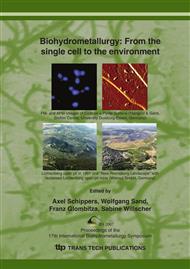p.405
p.409
p.413
p.417
p.423
p.427
p.431
p.435
p.439
Interactions of Acidithiobacillus ferrooxidans with Heavy Metals, Various Forms of Arsenic and Pyrite
Abstract:
An arsenic resistant ferrous iron oxidizing bacterium Acidithiobacillus ferrooxidans (GenBank no. EF010878) was isolated from reactor leachate. The reactor leachate showed extreme environmental parameters. Ferrous iron concentrations of more than 60 g/L were found to be inhibitory in the presence and absence of arsenite. Ks values of 12.5 and 8.0 g/L ferrous sulphate and Vmax of 0.124 and 0.117 g/L/h/0.8 mg of protein were found in the presence and absence of arsenite respectively. At 14.9 g/L of arsenite and arsenate the culture showed 26.8 and 59.7 % ferrous iron oxidizing activity respectively. Amongst the metals studied, copper was found to be more toxic as compared to nickel and zinc. In the presence of 3.51 g/L nickel or 4.68 g/L zinc, about 30 % biooxidation activity was registered. In the pyrite oxidation study 87, 67 and 64 % of pyrite oxidation was found and 2.02, 3.19 and 5.96 g/L total iron was solubilized with 5, 10 and 20 g/L of pyrite respectively. The isolate was also able to oxidize refractory arsenopyrite gold ore and 0.531 g/L of arsenic was solubilized along with 0.872 g/L of soluble total iron. During this period the numbers of planktonic bacteria increased from 2.4 x 106 to 1.0 x 108 cells/mL.
Info:
Periodical:
Pages:
423-426
Citation:
Online since:
July 2007
Authors:
Keywords:
Price:
Сopyright:
© 2007 Trans Tech Publications Ltd. All Rights Reserved
Share:
Citation:


